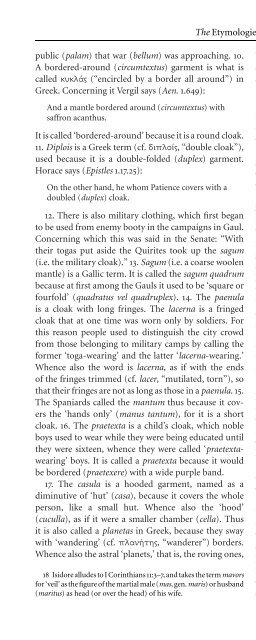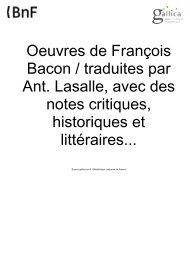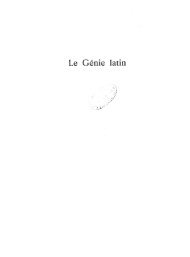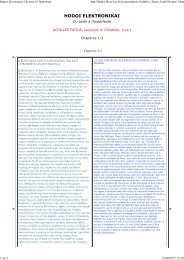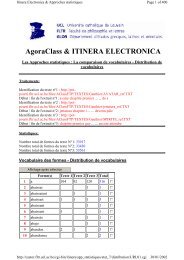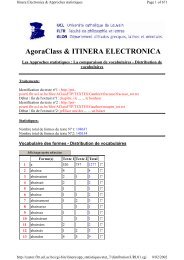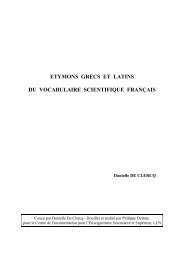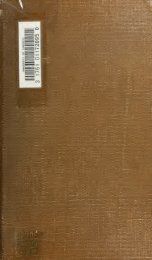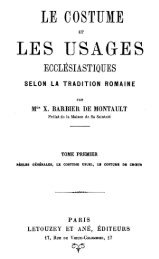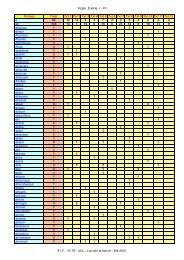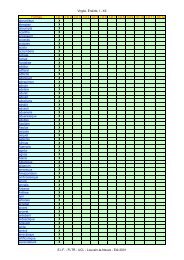The Etymologies of Isidore of Seville - Pot-pourri
The Etymologies of Isidore of Seville - Pot-pourri
The Etymologies of Isidore of Seville - Pot-pourri
Create successful ePaper yourself
Turn your PDF publications into a flip-book with our unique Google optimized e-Paper software.
public (palam) that war (bellum) was approaching. 10.<br />
Abordered-around (circumtextus) garment is what is<br />
called (“encircled by a border all around”) in<br />
Greek. Concerning it Vergil says (Aen. 1.649):<br />
Andamantle bordered around (circumtextus) with<br />
saffron acanthus.<br />
It is called ‘bordered-around’ because it is a round cloak.<br />
11. Diplois is a Greek term (cf. ,“double cloak”),<br />
used because it is a double-folded (duplex) garment.<br />
Horace says (Epistles 1.17.25):<br />
On the other hand, he whom Patience covers with a<br />
doubled (duplex) cloak.<br />
12. <strong>The</strong>re is also military clothing, which first began<br />
to be used from enemy booty in the campaigns in Gaul.<br />
Concerning which this was said in the Senate: “With<br />
their togas put aside the Quirites took up the sagum<br />
(i.e. the military cloak).” 13. Sagum (i.e. a coarse woolen<br />
mantle) is a Gallic term. It is called the sagum quadrum<br />
because at first among the Gauls it used to be ‘square or<br />
fourfold’ (quadratus vel quadruplex). 14. <strong>The</strong>paenula<br />
is a cloak with long fringes. <strong>The</strong> lacerna is afringed<br />
cloak that at one time was worn only by soldiers. For<br />
this reason people used to distinguish the city crowd<br />
from those belonging to military camps by calling the<br />
former ‘toga-wearing’ and the latter ‘lacerna-wearing.’<br />
Whence also the word is lacerna, asifwiththe ends<br />
<strong>of</strong> the fringes trimmed (cf. lacer, “mutilated, torn”), so<br />
that their fringes are not as long as those in a paenula. 15.<br />
<strong>The</strong> Spaniards called the mantum thus because it covers<br />
the ‘hands only’ (manus tantum), for it is a short<br />
cloak. 16. <strong>The</strong>praetexta is a child’s cloak, which noble<br />
boys used to wear while they were being educated until<br />
they were sixteen, whence they were called ‘praetextawearing’<br />
boys. It is called a praetexta because it would<br />
be bordered (praetexere)withawidepurple band.<br />
17. <strong>The</strong> casula is a hooded garment, named as a<br />
diminutive <strong>of</strong> ‘hut’ (casa), because it covers the whole<br />
person, like a small hut. Whence also the ‘hood’<br />
(cuculla), as if it were a smaller chamber (cella). Thus<br />
it is also called a planetas in Greek, because they sway<br />
with ‘wandering’ (cf. , “wanderer”) borders.<br />
Whence also the astral ‘planets,’ that is, the roving ones,<br />
18 <strong>Isidore</strong> alludes to I Corinthians 11:3–7, and takes the term mavors<br />
for ‘veil’ as the figure <strong>of</strong> the martial male (mas,gen.maris)orhusband<br />
(maritus) ashead(orover the head) <strong>of</strong> his wife.<br />
<strong>The</strong> <strong>Etymologies</strong> XIX.xxiv.10–xxv.7 387<br />
because they course about in their own erratic straying<br />
and motion. 18. Birrus (i.e. a rain cloak) is taken from<br />
aGreekword, for they say a birrus as bibrus (cf. <br />
,“cloak”). 19.<strong>The</strong>melotes,which is also called a pera<br />
(lit. “bag”), is the skin <strong>of</strong> a goat which hangs from the<br />
neck and covers as far as the loins. Strictly speaking, this<br />
is the outfit needed for laboring. It was first made, as<br />
some people think, from the skins <strong>of</strong> martens (melo,i.e.<br />
meles), whence they are called melotes. 20.<strong>The</strong>fringes <strong>of</strong><br />
garments, that is, the edges, are called the border (ora),<br />
derived from a Greek word, for the Greeks call a border<br />
.<br />
xxv. Women’s outer garments (De palliis feminarum)<br />
1.<strong>The</strong>regillum is the mantle <strong>of</strong> state for queens (regina),<br />
whence it is named. <strong>The</strong> peplum is a matron’s garment<br />
marked with purple, whose hem glitters at the edge with<br />
gold threads. 2. <strong>The</strong>palla is a woman’s garment that is<br />
asquarecloak (pallium). It hangs down to the feet and<br />
has gemstones fixed in a row. And it is called palla from<br />
the word (“sway”), that is, from the movement<br />
that occurs around the edge <strong>of</strong> such clothing, or because<br />
as it sways it ripples in fluttering folds. 3. <strong>The</strong>stola is a<br />
matron’s garment that, covering the head and shoulders,<br />
is ‘sent’ from the right side over the left shoulder. Furthermore,<br />
it is called stola,with a Greek word (i.e. ,<br />
“robe”; cf. , “send”), because it is ‘sent out on<br />
top.’ 4. Thisisalso called by the Latin term ricinium<br />
(i.e. ‘veil’) because half <strong>of</strong> it is flung back (reicere). People<br />
commonly call it a mavors (lit. the archaic name for<br />
Mars; cf. ,“veil, headdress”). It is called mavors<br />
as if the term were Mars,for it possesses the mark <strong>of</strong> marital<br />
(maritalis)dignity and authority, for man is the head<br />
<strong>of</strong> woman, whence this garment is worn over a woman’s<br />
head. 18<br />
5. <strong>The</strong>amiculum is the linen cloak <strong>of</strong> prostitutes. In<br />
ancient times, married women caught in adultery were<br />
clothed in these so they might sully their virtue in this<br />
amiculum rather than in a stola.Thusamong the ancients<br />
this garment was a mark <strong>of</strong> prostitution, but nowadays in<br />
Spain it is a mark <strong>of</strong> respectability. 6.<strong>The</strong>theristrum is a<br />
veil with which the women <strong>of</strong> Arabia and Mesopotamia<br />
are covered even today; in the heat they are very well<br />
protected by its shade. Isaiah (3:23) speaksconcerning<br />
it. 7. <strong>The</strong>anaboladium is a linen cloak for women that<br />
covers their shoulders. Greek (cf. , “linen veil”)<br />
and Latin speakers call it a sindon.


